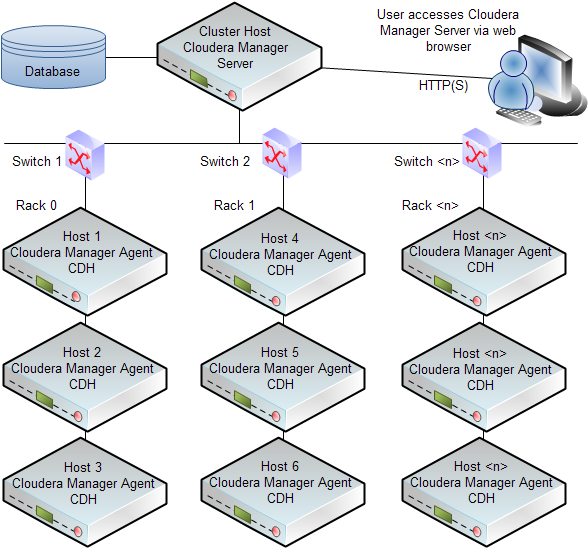Introduction to Cloudera Manager Installation
- A small self-executing Cloudera Manager installation program to install the Cloudera Manager Server and other packages in preparation for host installation.
- Cloudera Manager wizard for automating CDH and managed service installation and configuration on the cluster hosts. Cloudera Manager provides two methods for installing CDH and managed services: traditional packages (RPMs or Debian packages) or parcels. Parcels simplify the installation process, and more importantly allows you to download, distribute, and activate new minor versions of CDH and managed services from within Cloudera Manager.
About the Cloudera Manager Installation Program
The Cloudera Manager installation program, which you install on the host where you want the Cloudera Manager Server to run:
- Installs the package repositories for Cloudera Manager and the Oracle Java Development Kit (JDK) 1.7
- Installs the Cloudera Manager Server
- Installs and configures an embedded PostgreSQL database for use by the Cloudera Manager Server and some Cloudera Management Service roles, Hive Metastore, and Cloudera Navigator Audit Server
Installing Cloudera Manager for the First Time
- Optionally install a database application on the Cloudera Manager Server host or on a host that the Cloudera Manager Server can access, and (depending on the configuration you decide on) on other hosts as well.
- Run the Cloudera Manager installer on one host.
- Install CDH, managed services, and Cloudera Manager Agents on the other hosts.

About the Cloudera Manager "First Run" Wizard
- Discover cluster hosts
- Optionally install the Oracle JDK
- Optionally install CDH, managed service, and Cloudera Manager Agent software on the hosts
- Select which services to run
- Specify the mapping of service roles to hosts
- Confirm service configurations and start the services
Installation Phases and Paths for Cloudera Manager, CDH, and Managed Services
The following diagram illustrates the phases required to install Cloudera
Manager, CDH, and managed services. Every phase is required, but there are multiple
ways to accomplish each phase, depending on your organization's policies and
requirements. 
The six phases are
grouped into three installation paths based on how the Cloudera Manager Server and
database software is installed on the Cloudera Manager Server and cluster hosts. For
each path you can choose to use the embedded PostgreSQL database or an external
database. To review the criteria for choosing a path, see Installing Cloudera Manager, CDH, and Managed Services.
| << Cloudera Manager Installation Guide | Cloudera Manager Requirements >> | |